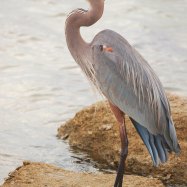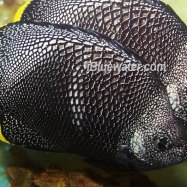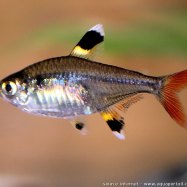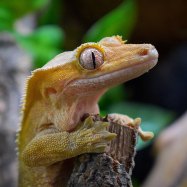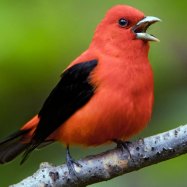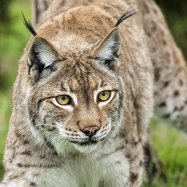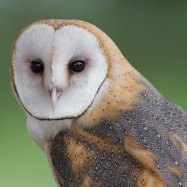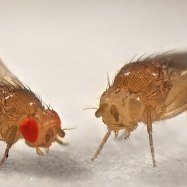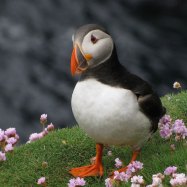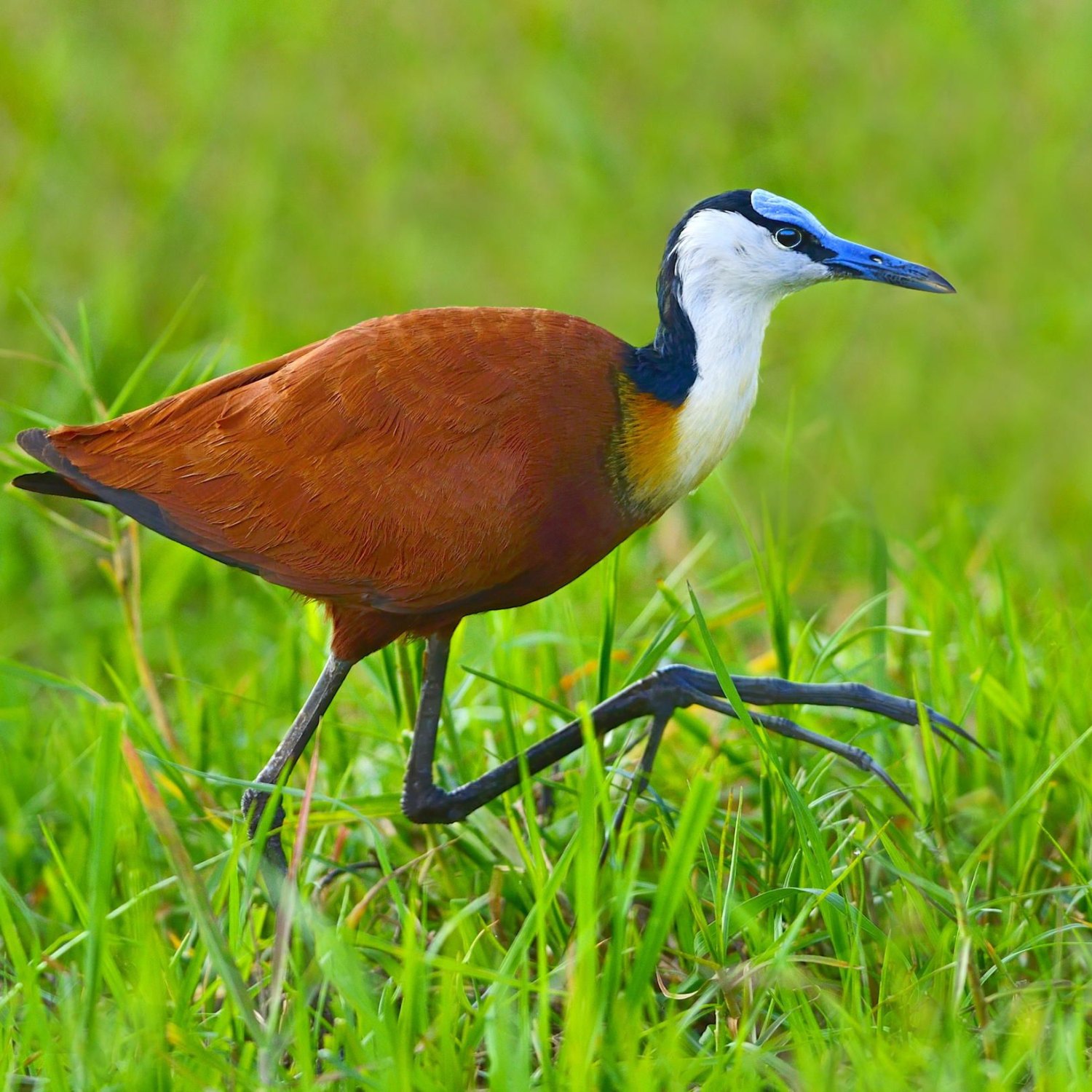
African Jacana
30-35 cm (11.8-13.8 in)
Meet the African Jacana, also known as a lily trotter. This beautiful bird can be found in wetlands and shallow freshwater habitats, with a slender and elongated body measuring between 30-35 cm (11.8-13.8 in). With its unique body shape and elegant long toes, the African Jacana is a must-see for any nature lover. Keep an eye out for this graceful creature on your next wetland adventure! #AfricanJacana #NatureLover #Wetlands
Animal Details Summary:
Common Name: African Jacana
Kingdom: Animalia
Habitat: Wetlands
A Fascinating Exploration of the African Jacana: The King of Wetland Birds
If you stroll along the lush and vibrant wetlands of Sub-Saharan Africa, you might be lucky enough to catch a glimpse of a graceful bird with striking black, brown, and white coloring. This magnificent creature is none other than the African Jacana, also known by its scientific name - Actophilornis africanus.Nestled in the kingdom of Animalia, within the phylum of Chordata, the African Jacana belongs to the class of Aves. It is then further classified under the order of Charadriiformes and the family of Jacanidae African Jacana. Let's dive deep into the world of this extraordinary bird and discover its unique features, habitat, and way of life.
The Habitat of the African Jacana
The African Jacana is a waterbird species that is found across several countries in Sub-Saharan Africa, such as Kenya, Uganda, Botswana, Zambia, and many more. They have a wide geographical distribution and can be found in various wetland habitats, including swamps, lakes, lagoons, and shallow freshwater areas.The Jacana's feet and toes are essential for its survival as they are perfectly adapted to walking on floating vegetation, such as lilies, where they spend most of their lives. This unique ability allows them to move swiftly across the water's surface, while also keeping them safe from predators.
The Feeding Method of the African Jacana
The African Jacana is classified as an omnivore, meaning that it feeds on a variety of foods such as insects, larvae, snails, spiders, and aquatic plants. However, they have a particular fondness for insects, making up a significant portion of their diet. As they move gracefully across the water's surface, the Jacana uses its impressive long toes to probe and peck at the plants and insects it finds beneath.Interestingly, the Jacana also has a unique feeding strategy, where it follows grazing animals, such as hippos and buffalos, to take advantage of the insects and small creatures that are disturbed by their movements American Coonhound. This clever tactic has earned the Jacana the nickname 'lily-trotter.'
The Stunning Characteristics of the African Jacana
The African Jacana has a striking appearance that makes it stand out among other waterbirds. Its long, slender legs are perfectly adapted to its aquatic lifestyle, as they allow the bird to navigate effortlessly through the water's surface. The bird's elongated toes are a defining feature, with the innermost toe being the longest, making it ideal for walking on floating vegetation.The African Jacana also has a slender and elongated body, measuring around 30-35 cm (11.8-13.8 in) in length. Its body is covered in beautiful black, brown, and white feathers, with the wings having a distinct white stripe across them. The male and female Jacanas look similar, but the male is slightly larger in size.
A Social and Family-oriented Species
The African Jacana is a social bird that lives in groups known as 'flocks.' These flocks can range from a few birds to several hundred, depending on the food availability and habitat. Interestingly, the Jacanas have a unique pair-bonding system, where males and females form a strong bond and mate for life. The male Jacana is responsible for incubating the eggs and caring for the chicks, while the female moves on to mate with other males.The Jacanas are also highly territorial and will fiercely defend their nesting sites from other birds. They make their nests by building floating platforms using floating vegetation and twigs in the wetland areas. These nesting sites also serve as roosting places for the Jacanas, where they can rest and hide from predators.
A Sounder of African Jacanas
One of the most interesting characteristics of the African Jacana is their distinct communication methods. Instead of making bird calls or songs, they use a unique sound, which has been described as 'tic-tac.' This sound is used to communicate with their flock and alert them of any potential dangers.Interestingly, while they are foraging, the African Jacanas also communicate through a series of head movements, which have been decoded to signify aggression, fear, or submission.
The Threats Facing African Jacanas
Despite being classified as a species of least concern by the International Union for Conservation of Nature (IUCN), the African Jacana still faces several threats to its survival. The primary threat is the degradation and destruction of wetland habitats due to human activities such as agriculture, mining, and urbanization. These activities lead to a decline in food sources and suitable nesting sites, which ultimately affects the Jacanas' breeding success.Furthermore, the African Jacana is also hunted for food and sport in some regions, further contributing to its declining population. Climate change is also a significant concern as it affects the water levels in wetlands and alters the Jacana's ability to walk on floating vegetation.
The Conservation Efforts for African Jacanas
Fortunately, several conservation efforts are being made to protect the African Jacana and its habitat. For instance, the African Jacana Conservation Project is working towards preserving and restoring wetland habitats in Kenya, Uganda, and Zambia. This project also conducts research to better understand the bird's behavior and ecology, while also engaging with local communities to raise awareness about the importance of protecting wetlands.Furthermore, wetland conservation laws and regulations are being implemented in various countries, along with the establishment of protected areas for the African Jacana. These efforts are crucial in ensuring the species' survival and maintaining the delicate balance of wetland ecosystems.
In Conclusion
The African Jacana is an extraordinary bird with many unique features and behaviors that have allowed it to thrive in Sub-Saharan Africa's diverse wetland habitats. With its stunning appearance, impressive abilities, and strong family bonds, the Jacana is a marvel of nature that deserves to be celebrated and protected.As we continue to learn more about this fascinating creature, it is crucial to remember our responsibility in preserving its habitat and ensuring its survival for generations to come. By working together, we can help the African Jacana continue to reign as the king of the wetlands and be a vital part of our natural world.

African Jacana
Animal Details African Jacana - Scientific Name: Actophilornis africanus
- Category: Animals A
- Scientific Name: Actophilornis africanus
- Common Name: African Jacana
- Kingdom: Animalia
- Phylum: Chordata
- Class: Aves
- Order: Charadriiformes
- Family: Jacanidae
- Habitat: Wetlands
- Feeding Method: Omnivorous
- Geographical Distribution: Sub-Saharan Africa
- Country of Origin: Multiple countries within Sub-Saharan Africa
- Location: Wetlands and shallow freshwater habitats
- Animal Coloration: Black, brown, white
- Body Shape: Slender and elongated
- Length: 30-35 cm (11.8-13.8 in)
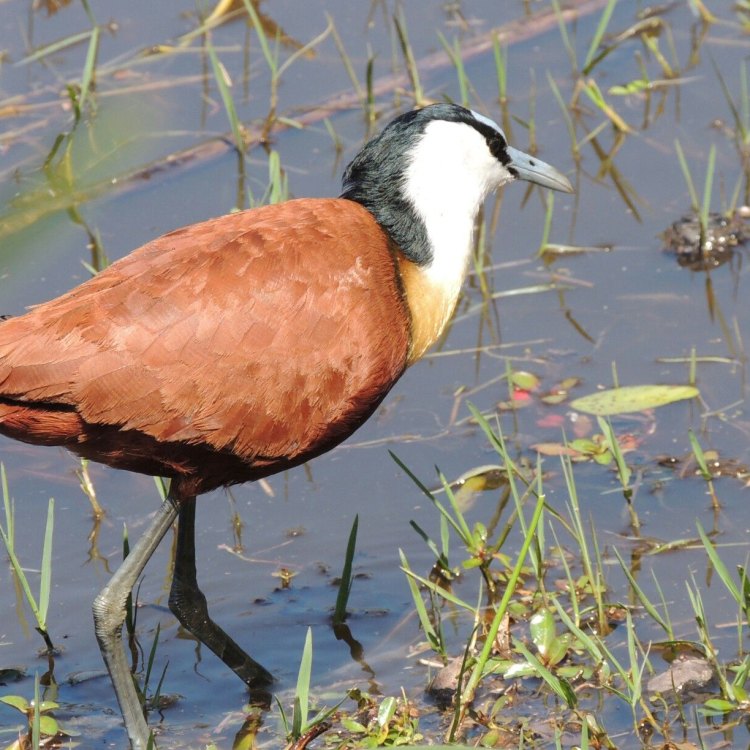
African Jacana
- Adult Size: Small
- Average Lifespan: 3-6 years
- Reproduction: Sexual
- Reproductive Behavior: Polyandrous
- Sound or Call: Loud, explosive calls
- Migration Pattern: Non-migratory
- Social Groups: Solitary or in small groups
- Behavior: Walks on floating vegetation, feeds on insects, small invertebrates, seeds, and plant matter
- Threats: Habitat loss, pollution, human disturbance
- Conservation Status: Least Concern
- Impact on Ecosystem: Important for seed dispersal
- Human Use: None
- Distinctive Features: Long toes and claws for walking on floating vegetation
- Interesting Facts: Females are larger and more brightly colored than males
- Predator: Crocodiles, snakes, large birds of prey
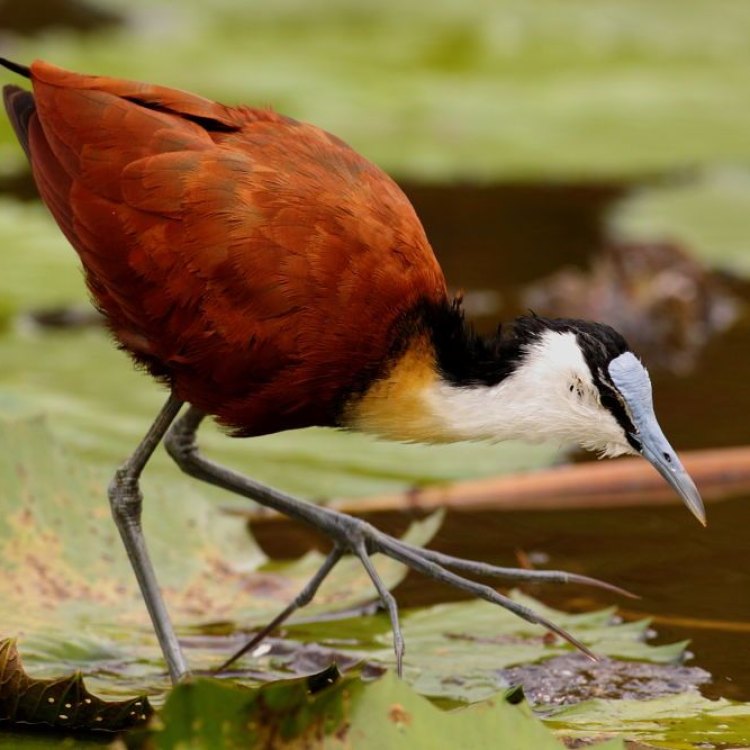
Actophilornis africanus
The Fascinating World of the African Jacana
The African Jacana, also known as the Lily-trotter or the Jesus bird, is a small wading bird found in sub-Saharan Africa. Despite its petite size, this bird has a lot of unique features that make it stand out in the avian world. From its distinctive long toes to its interesting reproductive behavior, the African Jacana is a fascinating species deserving of our attention.Adult Size:
Measuring only 7-9 inches long and weighing just over half a pound, the African Jacana is a small bird PeaceOfAnimals.Com. However, its small size doesn't affect its ability to thrive in its habitat. In fact, its small size allows it to walk on the floating vegetation that makes up its home.
Average Lifespan:
The lifespan of an African Jacana is relatively short, averaging between 3 to 6 years. This is due to the harsh conditions of its environment. However, this bird makes the most of its short lifespan by reproducing at an impressive rate.
Reproduction:
The African Jacana is a sexually reproducing bird, meaning that it requires both male and female individuals to reproduce. However, what makes this species particularly interesting is its polyandrous reproductive behavior. This means that one female will mate with multiple males, and the males take on most of the parental care responsibilities.
Reproductive Behavior:
As mentioned earlier, the African Jacana practices a polyandrous reproductive behavior, which is uncommon in the animal kingdom Armored Catfish. After mating, the female will lay her eggs in a floating nest made of plant material, usually in the form of a lily pad. The male birds will then incubate the eggs and care for the chicks once they hatch. This unique reproductive behavior allows the female to mate with multiple males, increasing the chances of successful mating and offspring survival.
Sound or Call:
The loud, explosive calls of the African Jacana can be heard throughout its habitat. These calls are used to communicate with other individuals and to defend its territory. This bird is not only visually striking but also has a powerful voice that cannot be ignored.
Migration Pattern:
Unlike many bird species, the African Jacana is non-migratory, meaning it does not migrate to different locations seasonally. Instead, it stays in its habitat year-round, adapting to the changing climate.
Social Groups:
African Jacanas are known to be solitary birds, and they mainly interact with other birds during mating season. However, outside of breeding season, they can also be seen in small groups, foraging for food together.
Behavior:
One of the most unique and fascinating behaviors of the African Jacana is its ability to walk on floating vegetation. Its long toes and claws allow it to distribute its weight evenly and prevent it from sinking. This behavior also helps the bird to access food sources that other birds cannot reach. The African Jacana's diet mainly consists of insects, small invertebrates, seeds, and plant matter, which it forages for on the floating vegetation.
Threats:
Like many other species, the African Jacana is facing environmental threats that put its survival at risk. Habitat loss due to human activities, pollution, and disturbances from human activities such as tourism and development are some of the major threats that this bird faces. As its habitat shrinks, so does its chances of survival.
Conservation Status:
Despite these threats, the African Jacana is currently listed as a species of least concern on the IUCN Red List. This means that the population of this bird is still relatively stable, and conservation efforts can focus on preventing further decline.
Impact on Ecosystem:
The African Jacana may be small, but it plays a crucial role in its ecosystem. As a seed disperser, this bird helps to spread plant species and maintain plant diversity in its habitat. It also serves as prey for larger predators, contributing to the balance of the food chain.
Human Use:
Unlike other bird species, the African Jacana is not utilized by humans for food, feathers, or any other purposes. This could be due to its small size and unobtrusive nature, making it less of a target for human consumption.
Distinctive Features:
The most distinctive feature of the African Jacana is its long toes and claws. These help it to walk on its unique habitat and access food sources that other birds cannot. It also has bright, vibrant colors, with the females being larger and more brightly colored than the males.
Interesting Facts:
Apart from its interesting reproductive behavior, there are many other fascinating facts about the African Jacana. Did you know that the name "Jesus bird" comes from its ability to seemingly walk on water due to its skill at walking on floating vegetation? Also, it is believed that its loud calls are used to attract mates and defend territory, as well as to warn other birds of predators.
Predators:
The African Jacana may have a unique ability to walk on water, but it is not invincible. Crocodiles, snakes, and large birds of prey are some of the predators that pose a threat to this bird. However, its camouflage and cautious nature help it avoid becoming prey.
In conclusion, the African Jacana may be a small bird, but it has a lot of unique and fascinating features. Its reproductive behavior, ability to walk on water, and distinctive physical characteristics make it stand out in the avian world. While it faces challenges, the African Jacana's survival is a reminder of the resilience and adaptability of nature. Let us continue to appreciate and protect this amazing species for future generations to enjoy.
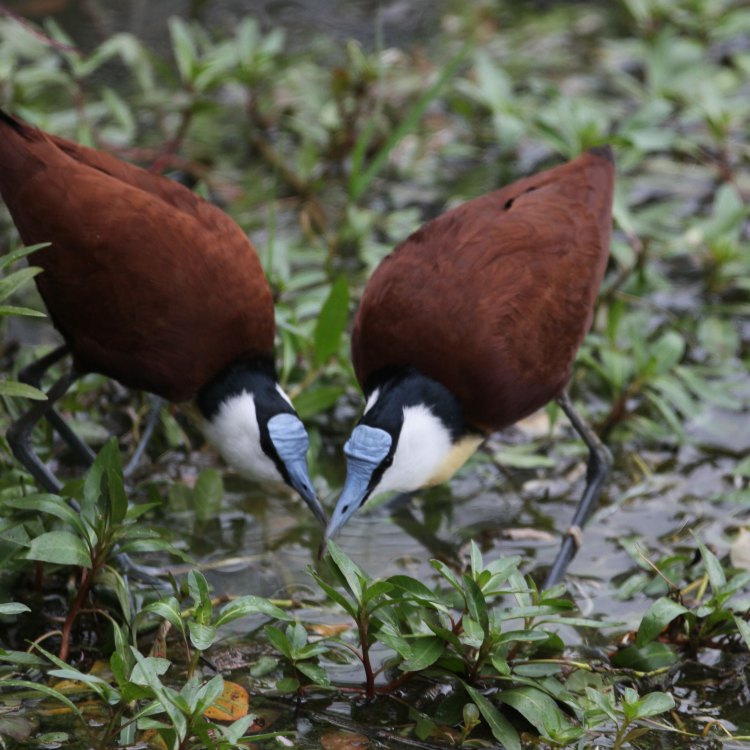
A Fascinating Exploration of the African Jacana: The King of Wetland Birds
Disclaimer: The content provided is for informational purposes only. We cannot guarantee the accuracy of the information on this page 100%. All information provided here may change without prior notice.

